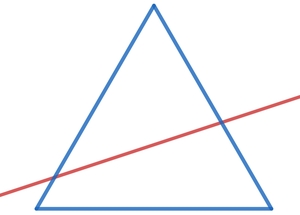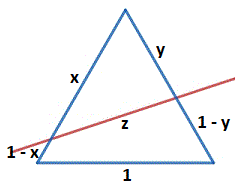Slashed Triangle

An equilateral triangle is split by a line into two regions with equal perimeters.
Find the maximum ratio of the areas of the two regions.
If the answer is b a for positive coprime integers a and b . Find a + b .
Bonus: Exchange the words 'perimeters' and 'areas' in the above question and then solve it.
The answer is 16.
This section requires Javascript.
You are seeing this because something didn't load right. We suggest you, (a) try
refreshing the page, (b) enabling javascript if it is disabled on your browser and,
finally, (c)
loading the
non-javascript version of this page
. We're sorry about the hassle.
2 solutions
If the line divides the triangle into regions of equal areas, what would be the maximum ratio of the perimeters of the two regions?
Log in to reply
Huh? I have got an idea.
Log in to reply
Do share your solution if you get it.. post it as a problem..
Log in to reply
@Digvijay Singh – OK. I will think about it
Log in to reply
@Chew-Seong Cheong – Turns out the answer is 2 − 3 1
Log in to reply
@Digvijay Singh – Wow! How do we get that?
Log in to reply
@Chew-Seong Cheong – The same approach as yours, but with complicated expressions and calculations.
@Chew-Seong Cheong – Confirm if my answer is correct, if you solve it.
Log in to reply
@Digvijay Singh – Yes, I got the same answer,
Log in to reply
@Chew-Seong Cheong – You may update your solution, as I've added it as a bonus problem.
Log in to reply
@Digvijay Singh – I solved it numerically. I will try to get an algebraic one.
1.12132035?
Log in to reply
It's 2 − 3 1 ≈ 1 . 0 8 0 8 8
Log in to reply
@Digvijay Singh – Haha, I took the question to disregard the length of the slashing line, just the original triangle perimeter. But thanks for the confirmation!
Let 1 be the side of the of the equilateral triangle, and x and y be the left and right sides of the upper triangle.

Since the perimeters are equal, x + y + z = ( 1 − x ) + 1 + ( 1 − y ) + z , or x + y = 2 3 .
The ratio of the areas is r a = 2 1 1 2 sin 6 0 ° − 2 1 x y sin 6 0 ° 2 1 x y sin 6 0 ° = 1 − x y x y
By AM-GM inequality, 2 3 = x + y ≥ 2 x y , or 1 6 9 ≥ x y , so the ratio of the areas has a maximum at r a = 1 − 1 6 9 1 6 9 = 7 9 , so that a = 9 , b = 7 , and a + b = 1 6 .
Bonus:
Since the areas are equal, the upper triangle is half the area of the equilateral triangle, so that 2 1 x y sin 6 0 ° = 2 1 ( 2 1 1 2 sin 6 0 ° ) or x y = 2 1 .
The ratio of the perimeters is r p = x + y + z ( 1 − x ) + 1 + ( 1 − y ) + z = x + y + z 3 − x − y + z .
By AM-GM inequality, ( 2 x + y ) 2 ≥ x y = 2 1 , or x + y ≥ 2 , with equality at x = y = 2 2 . If x = y , the upper triangle is an equilateral triangle, so z = x = y = 2 2 , so the ratio of the perimeters has a maximum at r p = 2 2 + 2 2 + 2 2 3 − 2 2 − 2 2 + 2 2 = 2 − 3 1 ≈ 1 . 0 8 0 8 8 .
Let the side length of the equilateral triangle be 1. Then the area of the equilateral triangle is A = 4 3 . Since the red line divides the equilateral triangle into two regions with equal perimeters and the two regions share a common red side, the total lengths of the blue sides of both regions are equal and is 2 3 . Let the length of a blue side of the triangular region be x , then the other blue side is 2 3 − x , and the area of the triangular region is A ′ = 2 1 x ( 2 3 − x ) sin 6 0 ∘ = 4 3 x ( 2 3 − x ) .
The ratio of areas of the two region is:
Q = A − A ′ A ′ = A − A ′ A − ( A − A ′ ) = A − A ′ A − 1 = 4 3 − 4 3 x ( 2 3 − x ) 4 3 − 1 = x 2 − 2 3 x + 1 1 − 1 = ( x − 4 3 ) 2 + 1 6 7 1 − 1
Then we have:
max ( Q ) = min ( ( x − 4 3 ) 2 ) + 1 6 7 1 − 1 = 0 + 1 6 7 1 − 1 = 7 9 when x = 4 3
Therefore, a + b = 9 + 7 = 1 6 .